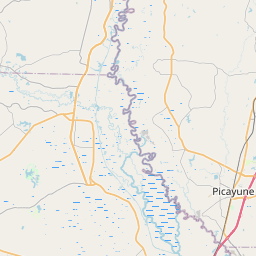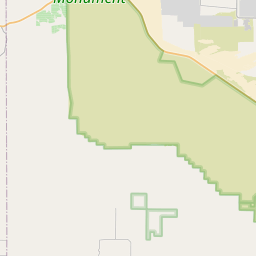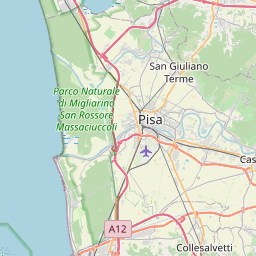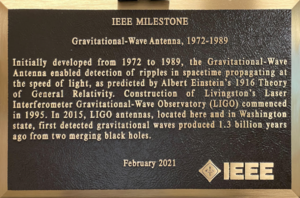Milestones:Gravitational-Wave Antenna, 1972-1989
Title
Gravitational-Wave Antenna, 1972-1989
Citation
Region 5: Livingston, LA LIGO plaque:
Gravitational-Wave Antenna, 1972-1989
Initially developed from 1972 to 1989, the Gravitational-Wave Antenna enabled detection of ripples in spacetime propagating at the speed of light, as predicted by Albert Einstein's 1916 Theory of General Relativity. Construction of Livingston's Laser Interferometer Gravitational-Wave Observatory (LIGO) commenced in 1995. In 2015, LIGO antennas, located here and in Washington state, first detected gravitational waves produced 1.3 billion years ago from two merging black holes.
Region 6: Richland (Hanford), WA LIGO plaque:
Gravitational-Wave Antenna, 1972-1989
Initially developed from 1972 to 1989, the Gravitational-Wave Antenna enabled detection of ripples in spacetime propagating at the speed of light, as predicted by Albert Einstein's 1916 Theory of General Relativity. Construction of Hanford's Laser Interferometer Gravitational-Wave Observatory (LIGO) commenced in 1994. In 2015, LIGO antennas, located here and in Louisiana, first detected gravitational waves produced 1.3 billion years ago from two merging black holes.
Region 8: Cascina (Pisa), Italy Virgo plaque:
Gravitational-Wave Antenna, 1972-1989
Initially developed from 1972 to 1989, the Gravitational-Wave Antenna enabled detection of ripples in spacetime propagating at the speed of light, as predicted by Albert Einstein's 1916 Theory of General Relativity. Construction of the Virgo Gravitational-Wave Observatory commenced in 1997. In 2017, Virgo and two antennas located in the U.S.A. launched the era of Multi-Messenger Astronomy with the coordinated detection of gravitational waves from a binary neutron star merger.
Street address(es) and GPS coordinates of the Milestone Plaque Sites
- Region 5 Site: 19100 LIGO Lane, Livingston, LA 70754 US (GPS: 30.5639, -90.77422)
- Region 6 Site: 127124 N Route 10, Richland, WA 99354 US (GPS: 46.4551589, -119.4096895)
- Region 8 Site: Via Amaldi, 56021 Santo Stefano a Macerata, Cascina (Pisa), Italy (GPS: 43.631222, 10.504021)
Details of the physical location of the plaque
- Region 5 Site: on the wall by the Control Room entrance inside the main building, as seen during public tours; tour information at https://www.ligo.caltech.edu/LA/page/Tours
- Region 6 Site: on an igneous Basalt Rock remnant to the right of the main building entrance, as seen during public tours; tour information at https://www.ligo.caltech.edu/WA/page/lho-tours-and-events
- Region 8 Site: by the flagpoles in front of the central detection building on a marble stele, to the right of a plaque commemorating the 2003 site's inauguration by French and Italian ministers
How the plaque site is protected/secured
- Region 5 Site: bolted to an interior wall; visitor control 24/7
- Region 6 Site: behind the access gate; visitor control 24/7
- Region 8 Site: behind the access gate; visitor control 24/7
Historical significance of the work
Following the progression of Human knowledge, four fundamental forces of nature have been identified. Early in our recorded history Earth, Wind, Water and Fire were considered by the Greek philosophers as the basis for explaining nature and the complexity of all matter. As our knowledge and scientific method evolved, we eventually identified the gravitational force, as described by Einstein’s General Theory of Relativity, and the other three forces as quantum fields that are described by the Standard Model of particle physics. The other three forces are the strong nuclear force, the weak nuclear force and the electromagnetic force. LIGO represents the first time gravitational waves, the force-carrier of gravity as predicted by Einstein over 100 years ago, were directly observed.
The gravitational force was first described in mathematical terms by Isaac Newton in 1687 by inferring that all matter exerted an attractive force directly related to the mass of individual objects and the square of the distance between them. From 1687 to the early 20th Century, Newton’s model reigned supreme. However, astronomical observations were made that defied explanation using Newton’s laws of motion. These observations were related to objects whose velocities approached that of the speed of light, and to objects subjected to very high gravitational fields. The observations made by astronomers over two centuries indicated that the orbit of Mercury deviated from that prescribed by Newton's laws of motion.
In 1915, Albert Einstein described in The General Theory of Relativity that gravity is the curvature of spacetime produced by the presence of mass-energy. Indeed, the anomalous precession of the perihelion of Mercury mentioned above was found to result from the intense gravitational field of the Sun. General Relativity further predicts that any rapid change in a gravitational field will travel through the Universe at the speed of light. These changes in the gravitational field are described as gravitational waves. From Dr. Weiss's original paper he stated, “In 1918, Einstein, using a weak-field approximation is his very successful geometrical theory of gravity (the general theory of relativity), indicated the form that gravitational waves would take in this theory and demonstrated that systems with time-variant mass quadrupole moments would lose energy by gravitational radiation. It was evident to Einstein that since gravitational radiation is extremely weak, the most likely measurable radiation would come from astronomical sources.” Given the requirements of the measurement, in his paper Dr. Weiss went on to describe a proposed antenna design capable of detecting the gravitational waves predicted by Einstein. In 1979 the National Science Foundation (NSF) funded Caltech and MIT to develop and mature the proposed gravitational wave antenna as described by Dr. Weiss. Following ten years of research and prototype development, Congress approved funding for LIGO in 1991, and construction of the sites began in 1994 and 1995. In parallel in Europe, Adalberto Giazotto from Italy and Alain Brillet from France, pioneered new methods of seismic isolation (“superattenuators”) and laser injection systems, later joined by Jean-Marie Mackowski on methods of production of extreme quality mirrors that formed the heart of the European proposal for the Virgo interferometer (1989), approved by CNRS and INFN in 1994 and whose construction started in 1997.
The first gravitational waves were simultaneously detected using the gravitational wave antenna at the two LIGO sites on September 14, 2015. The gravitational waves were produced by the merger of two black holes, in an event that occurred 1.3 billion years ago. The Virgo antenna obtained comparable sensitivities in August 2017 and, together with the two LIGO antennas in the US, was able to detect with unprecedented precision through triangulation, the site of two merging black holes, marking thus the beginning of precision gravitational wave astronomy. Three days later on the 17th of August the detection of a neutron star merger, again through the conjugated action of the three antennas (LIGO - Hanford, LIGO - Livingston and Virgo), permitted the follow-up of the event by nearly 70 electromagnetic observatories around the world, from the optical to radio wavelengths, thus marking a new beginning: this of “multi-messenger astronomy”. The direct detection of gravitational waves by LIGO resulted in co-founders Rainer Weiss, Barry Barish, and Kip Thorne receiving the 2017 Nobel Prize in Physics.
Obstacles (technical, political, geographic) that needed to be overcome
Because gravity is the weakest of the four fundamental forces, gravitational forces are exceedingly small and, before the invention of the gravitational wave antennas used on LIGO and VIRGO, were impossible to measure directly. A strong astrophysical gravitational wave, caused by some of the most energetic events in the Universe, will produce a displacement at Earth of order 10-18 meters (1 atto-meter), which is about 1000 times smaller than the diameter of a proton. Waves of this strength are produced by very massive systems undergoing extremely large accelerations, such as two black holes merging into one at over half the speed of light. This measurement capability has been made possible in part through the development and maturation of state-of-the-art technology in multiple electrical engineering disciplines including photonics, lasers, controls, computer systems, software, instrumentation, signal processing, etc. It took over 100 years of advanced multidisciplinary technology development to provide the capability of making sensitivity measurements capable of detecting gravity waves.
Features that set this work apart from similar achievements
There are no other similar achievements. The direct measurement of gravitational waves is a fundamental achievement.
Significant references
1) Reference for the original paper that described the detector: R. Weiss (1972), “Electromagnetically Coupled Broadband Gravitational Antenna” Quarterly Progress Report No. 105, Research Laboratory of Electronics, MIT, pg. 54 – 76. A PDF of that original paper is available here: https://dcc-lho.ligo.org/public/0038/P720002/001/19720018652.pdf
2) Construction Proposal: R. W. P. Drever, F. J. Raab, K. S. Thorne, R. Vogt, and R. Weiss, Laser Interferometer Gravitational-wave Observatory (LIGO) Technical Report, 1989, https://dcc.ligo.org/public/0065/M890001/003/M890001-03%20edited.pdf.
3) Prototype description: D. C. Coyne, 1996, "The Laser Interferometer Gravitational-Wave Observatory (LIGO) Project" 1996 IEEE Aerospace Applications Conference Proceedings, https://dcc-lho.ligo.org/public/0037/G960051/000/G960051-00.pdf
4) A. Giazotto, Phys. Reports 182, 365 (1989). A. Brillet, A. Giazotto et al., "VIRGO Proposal for the construction of a large interferometric detector of gravitational waves" (1989), https://www.ego-gw.it/public/about/VIRGO_Proposal_1989_VIR-0517B-15.pdf.
5) A. Brillet, A. Giazotto et al., "VIRGO Final Concept Design" (1992), https://www.ego-gw.it/public/about/VIRGO_Proposta_1987_VIR-0473B-15_clean.pdf (in Italian).
6) First gravitational wave detection: B. P. Abbott, et al., "Observations of Gravitational Waves from a Binary Black Hole Merger" Physical Review Letters, PRL 116, 061102 (2016), https://dcc-lho.ligo.org/public/0122/P150914/014/LIGO-P150914_Detection_of_GW150914.pdf
7) GW170814: A Three-Detector Observation of Gravitational Waves from a Binary Black Hole Coalescence LIGO Scientific and Virgo Collaborations (B.P. Abbott et al.) Phys.Rev.Lett. 119 (2017)
8) Detection of a binary star merger: B. P. Abbott, et al., "GW170817: Observation of Gravitational Waves from a Binary Neutron Star Inspiral" Physical Review Letters, PRL 119, 161101 (2017), https://dcc-lho.ligo.org/public/0145/P170817/008/LIGO-P170817.pdf
9) Parts of the Path to Today's Interferometric Gravitational-Wave Detectors, David Shoemaker, LIGO-G1401350-v4, Oct. 2014, Provides a good historical summary of the invention and development of the gravitational wave antenna. See https://dcc.ligo.org/public/0116/G1401350/004/GW%20interferometry%20--%20history%20to%20aLIGO%20v4.pptx.pdf
10) LIGO: The Dawn of Gravitational Wave Astronomy, Jameson Graef Rollins, LIGO-G1602295, PCaPAC 2016, Campinas, Brazil, Oct. 26, 2016 - Provides a good summary of what gravity waves are, the principles behind detecting them, an overview of the observatories, early measurements, and path forward. Contains several embedded Youtube videos. See https://dcc.ligo.org/public/0139/G1602295/001/main.pdf
11) Interferometric Detection of Gravitational Waves, Adalberto Giazotto, Phsics Reports (Review Section of Physics Letters) 182, No. 6 (1989) 365 - 424, North=Holland, Amsterdam, https://www.ego-gw.it/public/about/Giazotto_Physics_Reports_1989.pdf
12) For a brief summary of the European Gravitational Observatory, see https://www.ego-gw.it/public/about/welcome.aspx.
Supporting materials
- Background information about the Gravitational Wave Antennas and this Milestone can be found at https://www.GWAmilestone.com/
- Louisiana Lt. Governor Billy Nungesser: Video of Thanks to IEEE for this Milestone
Online Dedication Ceremony
Map













Map













Map

























